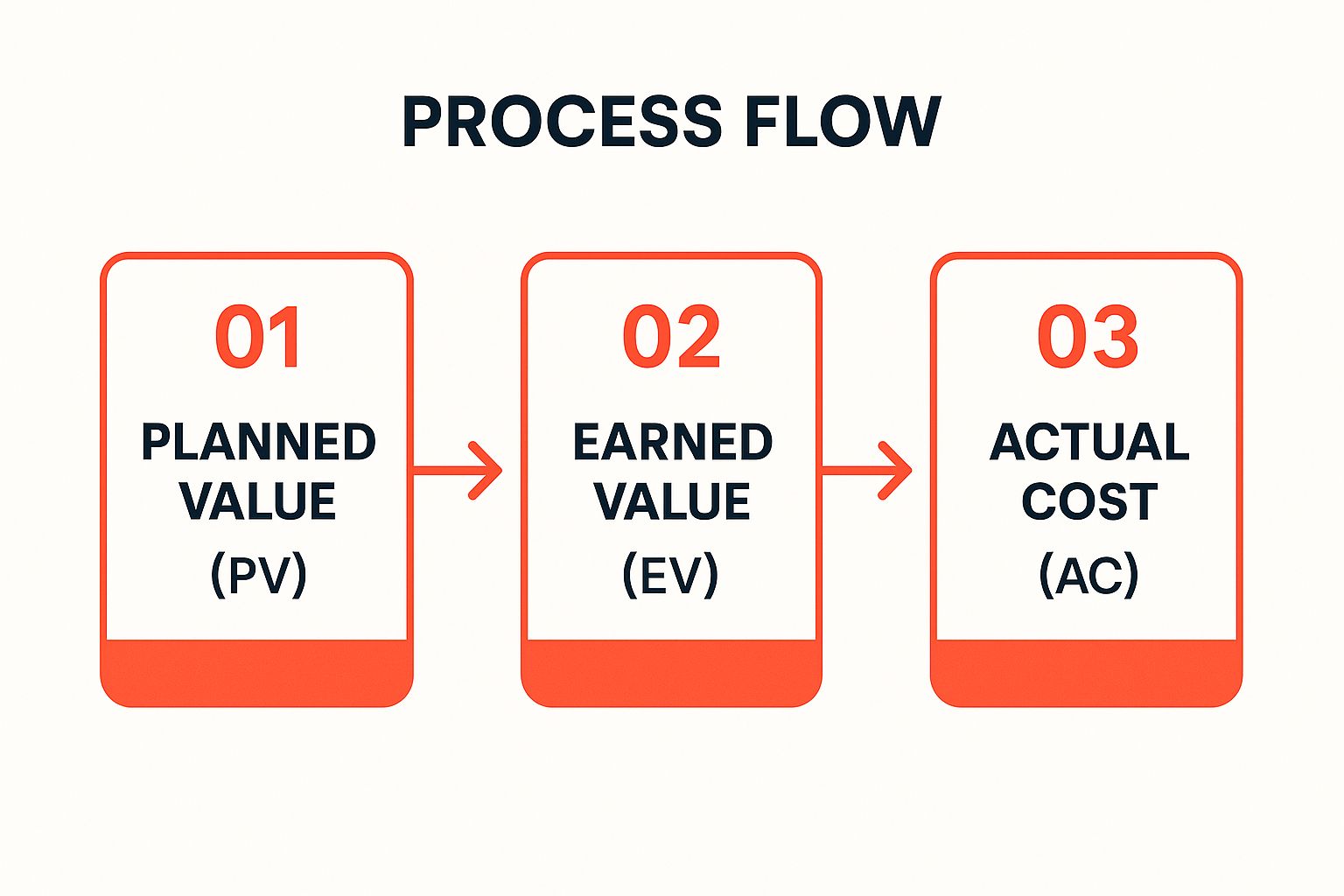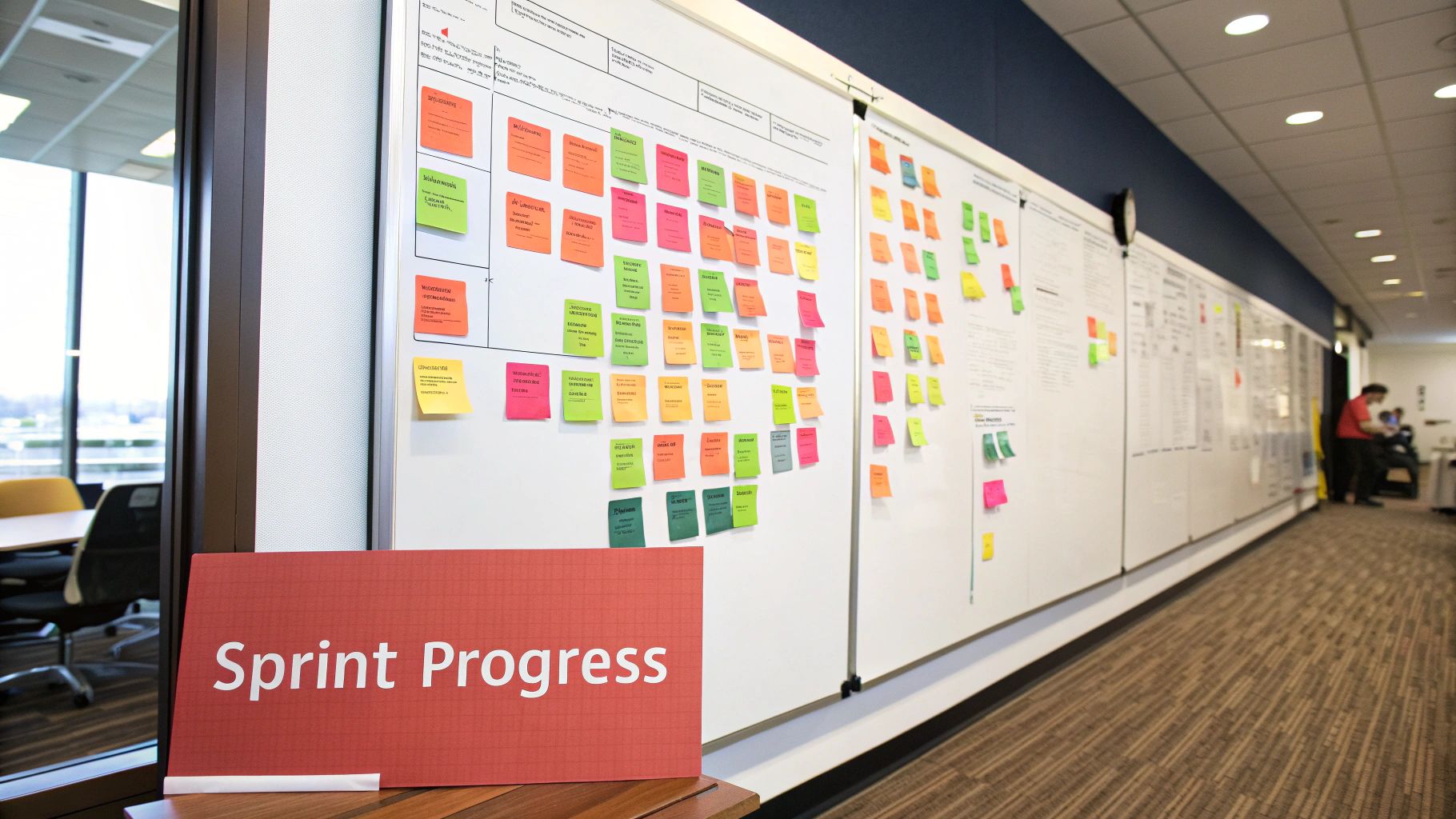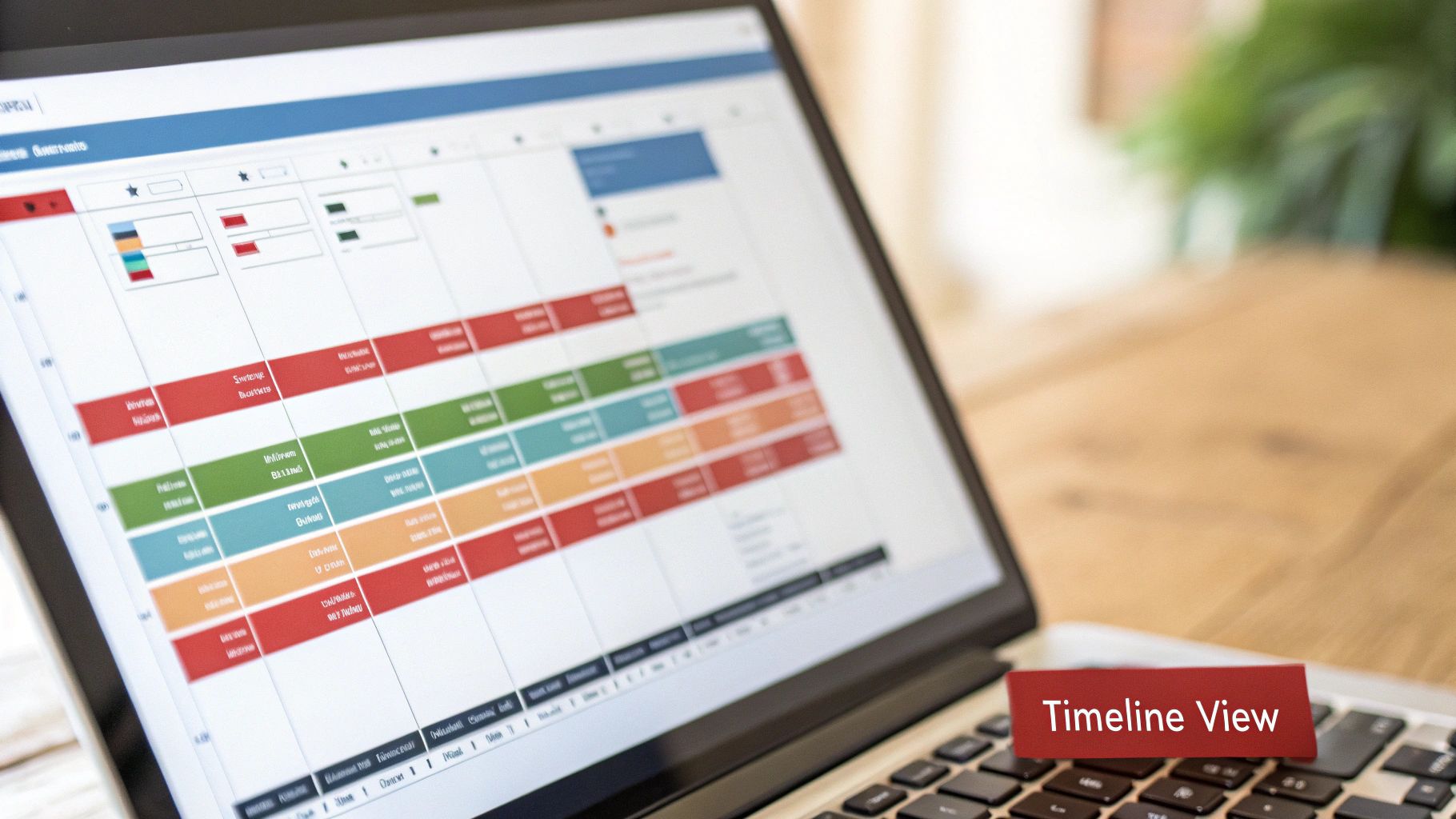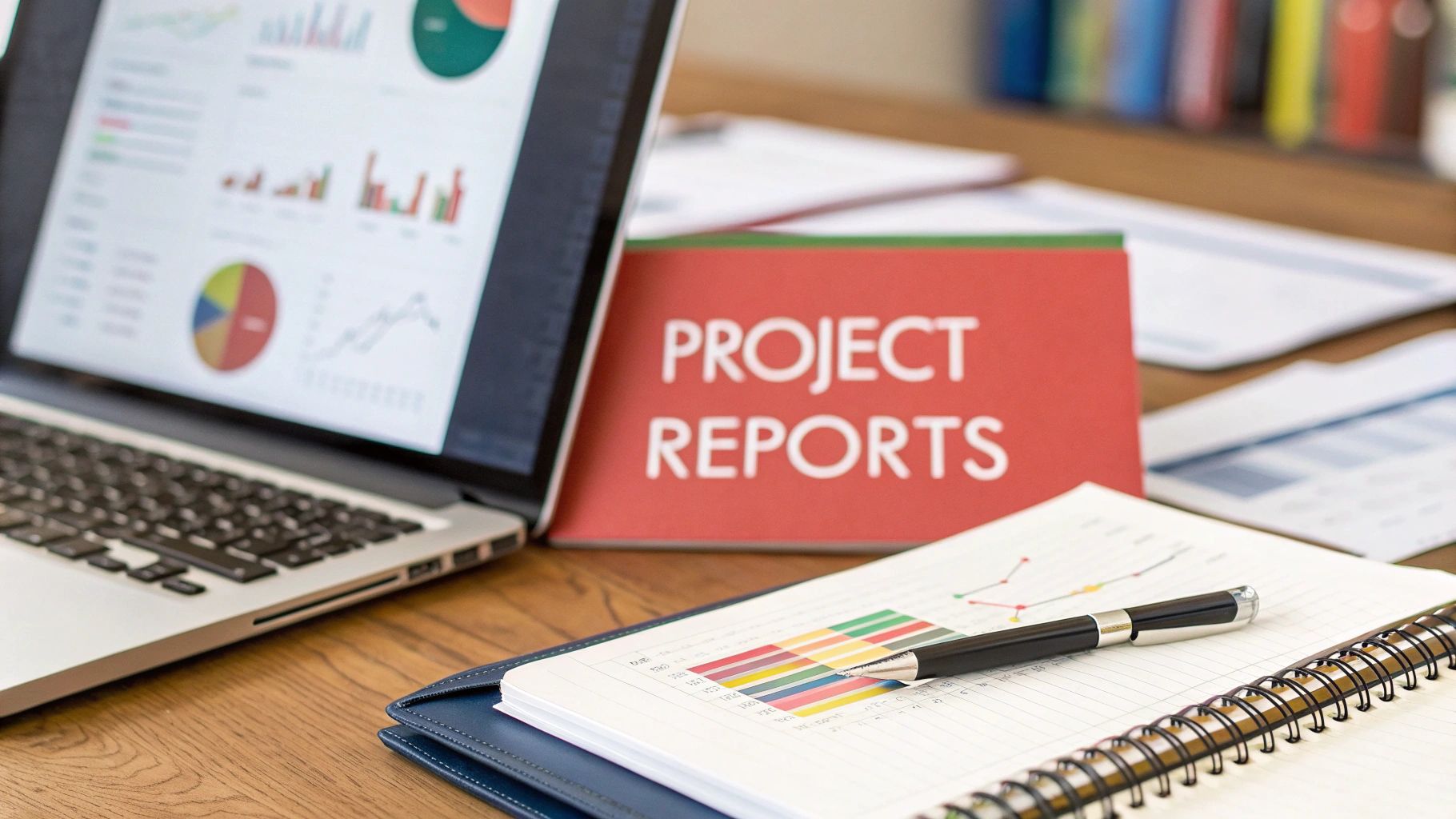For agencies, a project status report is more than a simple update; it is a critical client communication tool that builds trust, manages expectations, and showcases value. Generic, one-size-fits-all reports often fail to convey the full picture, leading to misaligned expectations, scope creep, and frustrated clients. Moving beyond basic templates is essential for demonstrating professional oversight and strategic control.
This guide moves beyond theory, offering a deep dive into six distinct project status report example formats tailored for the unique pressures and workflows of agency life. We will dissect each one to reveal its core strategic value and specific use case for client management and internal oversight.
You will learn how to:
- Select the right report format for different agency project types and client needs.
- Customize templates to highlight key metrics and agency contributions.
- Communicate progress, risks, and next steps with absolute clarity to clients and stakeholders.
We will break down the strategic purpose for each example, from high-level executive dashboards for client-side VPs to detailed agile sprint reports for your dev team. By mastering these formats, your agency can transform reporting from a tedious chore into a strategic asset that strengthens client relationships and drives project success.
1. RAG Report Example: For Quick Client & Portfolio Health Checks
The RAG (Red, Amber, Green) status report is a universally recognized system that provides an at-a-glance overview of project health. It uses a simple, intuitive traffic light color code: Red for critical issues needing immediate action, Amber for potential risks or minor delays, and Green for projects that are on track. This visual shortcut is incredibly effective for agencies managing multiple client projects, allowing account managers and leadership to instantly gauge portfolio health and prioritize their attention.

This method shines in its ability to transcend technical jargon, making it a powerful communication tool between project teams, account managers, and clients who may not be involved in the day-to-day minutiae. A well-implemented RAG report acts as an early warning system, preventing minor hiccups from escalating into major crises.
Strategic Analysis: Why It Works for Agencies
The power of this project status report example lies in its simplicity and universal understanding. For a busy digital or creative agency juggling dozens of client deliverables, the RAG system cuts through the noise. It forces project managers to make a definitive judgment on the status of key areas like budget, scope, and timeline, which fosters accountability.
Key Insight: The RAG system’s primary value is not just reporting the status but forcing a clear, decisive assessment. A project manager can't hide behind vague language; they must commit to a color, which then triggers a predefined response from leadership or the client.
For instance, an Amber status on a marketing campaign’s budget immediately signals to the account manager to investigate potential overages, while a Red status on a software development timeline demands an urgent, all-hands-on-deck meeting. This clarity is crucial for maintaining client trust and profitability.
Actionable Takeaways for Agency Implementation
To successfully deploy a RAG system in your agency, focus on standardization and clarity.
- Green: On schedule, within 5% of budget, no major roadblocks.
- Amber: Potential for 5-10% budget overage, a key deliverable is at risk of a minor delay (<1 week).
- Red: Over 10% of budget, a critical milestone will be missed, client satisfaction is at risk.
2. Executive Dashboard Example: For High-Value Client and Leadership Reporting
The Executive Dashboard is a high-level, visually-driven status report designed specifically for C-suite executives, agency partners, and senior client stakeholders. Unlike granular, task-oriented reports, this format prioritizes brevity and strategic insight. It translates complex project data into easily digestible KPIs, charts, and top-line summaries focused on budget burn, timeline progress, major milestones, and overall return on investment (ROI). This allows decision-makers to assess the health of a key account or a portfolio of projects in minutes, not hours.
This type of report is essential for agencies needing to communicate strategic value to clients or internal leadership. It moves the conversation away from daily tasks and toward business outcomes. Tools like Power BI, Tableau, or even custom-built dashboards are commonly used to aggregate data from various sources into a single, cohesive view, making this a powerful project status report example for demonstrating strategic command.
Strategic Analysis: Why It Works for Agencies
The Executive Dashboard’s strength is its ability to communicate the "so what?" behind the data. For agency leaders and client-side executives, the primary concerns are strategic: Are we on track to hit our goals? Is the investment generating the expected return? Is the project still aligned with our business objectives? This report answers those questions directly and visually, bypassing the operational weeds.
Key Insight: The Executive Dashboard is a tool for strategic alignment, not just project tracking. Its purpose is to facilitate high-level decisions by presenting data in the context of business goals, such as client profitability, resource allocation, and portfolio risk.
For an agency, presenting a sophisticated dashboard to a client can reinforce its position as a strategic partner, not just a vendor. It shows a commitment to the client's business success and provides a transparent, professional medium for discussing performance, potential pivots, and future opportunities. This elevates the client-agency relationship beyond simple deliverable fulfillment.
Actionable Takeaways for Agency Implementation
To create an effective Executive Dashboard, the focus must be on relevance and clarity for a time-poor audience.
- Limit to Critical Metrics: Resist the urge to include every possible data point. Select 5-7 key metrics that tell the most important story. For an agency, this could include Budget vs. Actual, Key Milestone Completion (e.g., "Campaign Live"), Overall Project ROI, Resource Utilization, and a high-level Risk Assessment.
- Emphasize Trend Analysis: Don't just show a snapshot of the current status; display trends over time. A chart showing budget burn over the last three months is far more insightful than a single number. This helps executives anticipate future challenges or opportunities.
- Design for "At-a-Glance" Consumption: Use clear data visualizations like bar charts for comparisons, line charts for trends, and gauges for KPI status. Maintain consistent branding and a clean layout to ensure the report is professional and easy to navigate. The goal is instant comprehension.
3. Earned Value Management (EVM) Report Example: For Large, Budget-Intensive Agency Projects
The Earned Value Management (EVM) status report is a powerhouse for project control, ideal for large-scale, high-stakes agency projects where budget and schedule are inextricably linked. It moves beyond simple tracking by integrating scope, schedule, and cost into a single, unified framework. By comparing Planned Value (PV), Earned Value (EV), and Actual Cost (AC), EVM provides objective, data-driven insights into project performance and forecasts future outcomes with remarkable accuracy. This method is the gold standard for complex agency undertakings like major software builds or large-scale digital transformation projects where clients demand rigorous financial accountability.
This infographic illustrates the core data flow of the EVM process, showing how value is planned, earned, and measured against actual costs.

The diagram highlights the crucial comparisons at the heart of EVM, enabling agency teams to calculate schedule and cost variances by analyzing the gaps between PV, EV, and AC.
Strategic Analysis: Why It Works for Agencies
For an agency managing a multi-million dollar website overhaul or a year-long digital transformation initiative, a simple RAG status is insufficient. The EVM project status report example provides the quantitative proof needed to manage client expectations and internal resources effectively. Its strength lies in answering critical questions with data: "Are we getting the value we planned for the money we've spent?" and "Based on current performance, when will we finish and what will be the final cost?"
Key Insight: EVM’s core benefit is its predictive power. By calculating performance indices like the Cost Performance Index (CPI) and Schedule Performance Index (SPI), an agency can forecast budget overruns or schedule delays long before they become critical, allowing for proactive course correction.
This forecasting ability is invaluable. If a project's CPI dips below 1.0, it’s a clear, objective signal that the project is over budget for the work completed. This allows project managers to address the root cause, whether it’s inefficient resource allocation or unmanaged scope changes, and present a data-backed plan to the client. This level of financial transparency builds immense trust with high-value clients.
Actionable Takeaways for Agency Implementation
Implementing EVM requires discipline and a structured approach, but the payoff in project control is immense.
- Establish a Solid Foundation: A detailed Work Breakdown Structure (WBS) is non-negotiable. Each work package in the WBS must have a defined budget (PV) to serve as your performance baseline. Without this, EVM calculations are meaningless.
- Focus on Trends, Not Blips: A single-point EVM report can be misleading. Analyze performance trends over several reporting periods. A consistently declining CPI is a serious red flag, whereas a one-time dip might just be a minor anomaly.
- Integrate and Automate: Manual EVM is cumbersome and prone to error. Use specialized EVM software or integrated project management tools to automate calculations. This frees up the project manager to focus on analyzing the data and developing strategic responses rather than crunching numbers. A key part of managing this is to learn how to prevent scope creep which can derail EVM metrics.
4. Agile Sprint Report Example: For Agency Software and Product Teams
The Agile Sprint Status Report is tailored for the fast-paced, iterative nature of Agile methodologies like Scrum. Unlike traditional monthly reports, this format focuses on short, time-boxed cycles (sprints), providing a real-time snapshot of team performance, progress against sprint goals, and any obstacles. Key elements often include burndown charts to visualize work remaining, sprint velocity to measure output, and a list of completed user stories. This report is essential for software development and product teams within agencies, offering a transparent view of incremental progress to both internal stakeholders and clients.

This method moves beyond a simple "done" or "not done" status. It provides data-driven insights that empower teams to adapt quickly, making it a cornerstone of Agile culture as seen in teams at Spotify and Atlassian. For agencies, this transparency helps manage client expectations by showing consistent, demonstrable progress sprint-over-sprint.
Strategic Analysis: Why It Works for Agencies
The power of this project status report example is its focus on momentum and predictability over rigid, long-term plans. For an agency building a complex app or website, the Agile report proves value continuously, rather than asking a client to wait months for a single major reveal. It shifts the conversation from "When will it be done?" to "What did we accomplish this sprint, and what are we doing next?" This builds immense trust and collaborative energy.
Key Insight: The sprint report's value lies in its forward-looking, problem-solving nature. It's not just a record of the past two weeks; it's a diagnostic tool that uses data like velocity and burndown trends to forecast and improve future sprints.
For instance, a consistently flat burndown chart indicates a systemic impediment that needs immediate attention from the Scrum Master or agency leadership. A fluctuating velocity helps the team have a more honest conversation with the client about scope and timeline adjustments. This proactive stance is critical for maintaining project health and client relationships.
Actionable Takeaways for Agency Implementation
To implement effective sprint reporting, your agency should prioritize automation and team-centric metrics.
- Automate Data from Your Tools: Manually creating burndown charts is inefficient. Leverage integrations with tools like Jira or Asana to automatically pull data on story points completed, tasks remaining, and sprint velocity. This ensures accuracy and frees up the project manager’s time for analysis.
- Focus on Trends, Not Absolutes: A single sprint's velocity is just a data point. The real insight comes from the trend over several sprints. Is velocity increasing, suggesting the team is gelling? Or is it decreasing, signaling burnout or a persistent blocker?
- Balance Quantitative and Qualitative: Numbers tell only half the story. Supplement your burndown chart with qualitative insights, such as a summary of key challenges overcome or a list of impediments the team is facing. This context is crucial for management and clients to truly understand project health. For agencies looking to master this balance, you can learn more about best practices in software development project management.
5. Gantt Chart Report Example: For Visualizing Complex Project Timelines
A Gantt chart-based status report is a powerful visual tool that illustrates a project's schedule against time. It displays tasks as horizontal bars, showing start and end dates, durations, dependencies between tasks, and overall project progress. For agencies managing intricate, multi-phase projects like a website rebuild or a multi-channel product launch, this format provides unparalleled clarity on timeline performance and resource allocation.
This method excels at communicating complex schedules to both internal teams and clients. Stakeholders can instantly see how tasks are connected, identify the critical path (the sequence of tasks that determines the project's total duration), and understand the impact of any delays. It transforms a list of dates and tasks into a clear, intuitive project roadmap.
Strategic Analysis: Why It Works for Agencies
The strength of this project status report example is its ability to visualize dependencies and progress over time. For an agency, this is critical for managing client expectations and internal resources. If a client is late delivering content (a common agency challenge), the Gantt chart immediately shows the knock-on effect on the design, development, and launch phases, making a potentially difficult conversation data-driven and objective.
Key Insight: The Gantt chart’s primary value for agencies is not just tracking tasks, but visually communicating the consequences of timeline shifts. It serves as a single source of truth that aligns the client, account manager, and project team on schedule realities.
For instance, when a software development phase is delayed, the Gantt chart can clearly illustrate the subsequent impact on the QA testing schedule and the final deployment date. This visual evidence is far more compelling than a simple statement and helps justify scope or timeline adjustments, protecting agency profitability and team morale.
Actionable Takeaways for Agency Implementation
To use Gantt charts effectively in your agency reporting, focus on clarity and context rather than overwhelming detail.
- Create Summary and Detailed Views: Develop a high-level Gantt chart showing only major phases and key milestones for executive and client reports. Maintain a more detailed, task-level version for the internal project team to manage day-to-day execution.
- Highlight the Critical Path: Use color-coding or bolding to clearly mark the critical path. This helps everyone understand which tasks have zero slack and must be completed on time to avoid delaying the entire project.
- Compare Baseline vs. Actual Progress: An effective Gantt report includes the original planned timeline (the baseline) alongside the current, actual progress. This visual comparison makes it easy to spot variances and proactively address them before they become major issues. This feature is standard in tools like Smartsheet and Microsoft Project.
6. Kanban Board Report Example: For Tracking Continuous Agency Workflows
The Kanban board status report offers a dynamic, real-time view of project progress, making it a favorite for agile teams in software development and creative agencies. Rather than a static document, this report is a living snapshot of the workflow, visually representing tasks as they move through different stages like "To Do," "In Progress," and "Done." This method emphasizes continuous flow and makes bottlenecks immediately obvious.

Popularized by the Toyota Production System and adapted for knowledge work, Kanban is incredibly effective for agencies managing continuous delivery projects, like ongoing SEO retainers or app maintenance. It shifts the focus from rigid deadlines to a smooth, predictable flow of work, providing stakeholders with transparent, up-to-the-minute updates just by looking at the board.
Strategic Analysis: Why It Works for Agencies
The Kanban board serves as a powerful project status report example because it promotes transparency and empowers teams to self-manage. For an agency, this means less time spent by project managers chasing updates and more time spent on strategic oversight. The visual nature of the board helps everyone, from developers to account managers and even clients, understand task distribution and identify where work is getting stuck.
Key Insight: A Kanban report's primary value is its focus on flow efficiency over resource busyness. It reveals systemic issues, like an overloaded design queue or a QA bottleneck, that a traditional report might miss. This allows for data-driven process improvements rather than just reporting on dates.
For instance, if the "In Progress" column consistently hits its Work-In-Progress (WIP) limit while the "Done" column moves slowly, it’s a clear signal that the team is starting more work than it can finish. This insight is crucial for an agency's profitability and ability to deliver on client promises consistently. Tools like Trello, Jira, and Azure DevOps have built-in Kanban analytics that automate the reporting of metrics like cycle time and throughput.
Actionable Takeaways for Agency Implementation
To effectively use a Kanban board as a status report, focus on discipline and data.
- Set Strict WIP Limits: The magic of Kanban is in its constraints. Set explicit limits on the number of tasks allowed in each "in-progress" stage. This prevents multitasking and forces the team to focus on completing work before starting new tasks.
- Visualize Blockers and Aging Tasks: Use visual cues like red flags for blocked tasks or color-coding for tasks that have been in one stage for too long. This helps the team quickly identify and swarm problems before they derail the workflow.
- Hold Regular Flow Reviews: Instead of a traditional status meeting, hold brief, regular meetings (daily stand-ups) focused on the board. The conversation should be about flow: "What's blocking us?" and "What can we do to move this card to the next column?"
- Use Metrics for Continuous Improvement: Track metrics like cycle time (how long a task takes from start to finish) and throughput (how many tasks are completed per week). Use these data points to refine your process, adjust WIP limits, and make more accurate forecasts for clients.
Which Agency Status Report is Right for Your Project?
Automating Your Reporting for Maximum Agency Efficiency
Throughout this guide, we've explored a diverse range of project status report example formats, each tailored to specific agency needs. From the at-a-glance clarity of a RAG report for busy stakeholders to the granular detail of an Earned Value Management (EVM) analysis for complex, budget-sensitive projects, the right template is a powerful communication tool. We've seen how Agile Sprint reports keep development cycles on track and how visual tools like Gantt charts and Kanban boards provide an intuitive snapshot of project flow.
The core lesson is clear: there is no one-size-fits-all solution. The most effective agencies don't just pick one report and stick with it. Instead, they build a versatile toolkit, selecting the perfect format based on the project's methodology, the client's communication style, and the specific information stakeholders need at that moment. Mastering this selection process is what separates proactive, strategic partners from agencies that simply provide updates.
From Manual Compilation to Automated Insight
Choosing the right format is the first step; streamlining its creation is the next critical leap toward agency excellence. Manually compiling data from disparate sources, chasing down updates from team members, and formatting everything for client presentation is a significant drain on your most valuable resource: your project manager's time. This manual-first approach is not just inefficient, it’s a direct barrier to scalability and profitability.
This is where modern technology can fundamentally revolutionize your agency's reporting workflow. Instead of dedicating hours to gathering inputs, you can automate the entire data collection and synthesis process. Imagine a world where key decisions from client calls are automatically transcribed, summarized, and flagged as action items. This isn't science fiction; it's the reality of AI-powered tools. These outputs can then be used to populate your chosen report template, whether that's providing the qualitative context for an 'Amber' status on a RAG report or updating task progress on a Kanban board.
Your Actionable Next Steps
To transform your reporting from a time-consuming chore into a strategic advantage, focus on integration and automation.
- Audit Your Current Process: Identify the biggest time sinks in your reporting workflow. Is it gathering data? Is it writing summaries? Pinpoint the primary bottleneck.
- Match Tools to Tasks: Based on your audit, find tools that solve your specific problems. An AI meeting assistant can handle call summaries, while project management software can automate progress tracking.
- Create Your "Master Template": For each report type you use (RAG, Agile, etc.), create a standardized, polished template. This ensures consistency and professionalism across all client accounts.
- Explore Integration: To truly achieve maximum agency efficiency, explore the best report automation tools available, which can significantly streamline your project reporting process by connecting your various software platforms.
By integrating automation, your agency can produce more accurate, timely, and insightful reports with a fraction of the manual effort. This frees up your project and account managers to focus on what truly drives client success: strategic thinking, problem-solving, and relationship-building. The ultimate goal is to make reporting a seamless background process, not a primary job function.
Ready to eliminate the manual work of turning client conversations into actionable report data? Scribbl uses AI to automatically transcribe, summarize, and extract key insights from your meetings. Stop taking notes and start populating your next project status report with perfect accuracy by trying Scribbl today.




